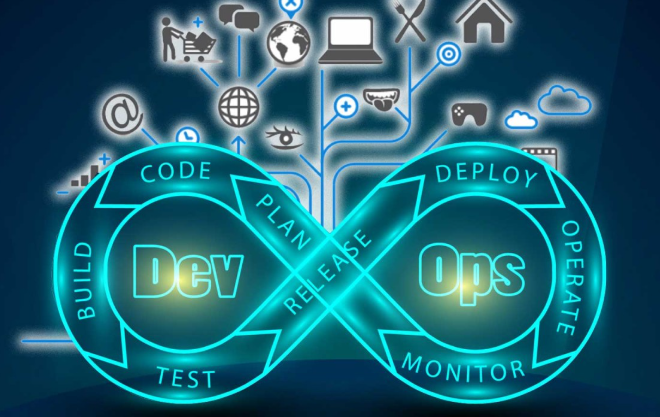DevOps with Full Stack refers to the integration of DevOps practices into a full-stack development environment. Full-stack developers are capable of working on both the frontend (client-side) and backend (server-side) aspects of a web application. When DevOps is applied in full-stack development, it helps streamline the development, testing, deployment, and monitoring processes for the entire application, including both the client and server sides.
Here’s how DevOps can be integrated into a full-stack development workflow:
1. Full Stack Development Overview
A full-stack developer works across all layers of an application, which typically includes:
- Frontend: The client-side of the application (HTML, CSS, JavaScript, frameworks like React, Angular, or Vue.js).
- Backend: The server-side logic, APIs, databases, and services (Node.js, Django, Ruby on Rails, Flask, etc.).
- Database: The data storage layer (SQL databases like PostgreSQL or MySQL, or NoSQL databases like MongoDB).
- Server and Infrastructure: The hosting environment (Cloud providers like AWS, Azure, or on-premise servers).
By integrating DevOps into the full-stack development workflow, teams can improve collaboration, automation, continuous integration, and delivery across all parts of the application.
2. DevOps in Full-Stack Development
Here’s how DevOps practices can be applied throughout the lifecycle of a full-stack application:
1. Version Control and Collaboration
- Tools: Git, GitHub, GitLab, Bitbucket
- Use Case: DevOps encourages version control practices, where the full-stack team manages the entire application code (frontend, backend, and infrastructure configurations) in a Git repository. This enables collaboration between frontend and backend developers while providing a history of changes.
- CI Integration: Version control tools integrate with Continuous Integration (CI) tools like Jenkins or CircleCI to automatically build and test every change made in the codebase.
2. Continuous Integration (CI)
- Tools: Jenkins, GitLab CI, CircleCI, Travis CI
- Use Case: CI tools help automate the process of integrating code changes, running automated tests, and ensuring that both frontend and backend code work seamlessly together. For example:
- Frontend CI: Automatically run tests for JavaScript, CSS, and HTML code to ensure the user interface works across browsers.
- Backend CI: Run tests on APIs, server-side code, and database interactions to ensure the application’s functionality.
3. Continuous Delivery/Continuous Deployment (CD)
- Tools: Jenkins, GitLab CI/CD, ArgoCD, CircleCI
- Use Case: Once the code is integrated and passes tests, CD tools automate the deployment of the full-stack application to various environments (staging, production).
- Frontend Deployment: For frontend, CD can deploy static assets (HTML, CSS, JavaScript) to a content delivery network (CDN) or cloud servers (e.g., AWS S3, Netlify, Vercel).
- Backend Deployment: For backend, CD can deploy APIs or services to cloud platforms (e.g., AWS EC2, Google Cloud, Heroku) or container orchestration platforms (e.g., Kubernetes, Docker Swarm).
4. Infrastructure as Code (IaC)
-
Tools: Terraform, Ansible, CloudFormation, Puppet, Chef
-
Use Case: DevOps encourages managing infrastructure (e.g., servers, databases, networks) using code. Full-stack teams can define infrastructure for both the frontend (e.g., load balancers, web servers) and backend (e.g., API servers, databases) using tools like Terraform and CloudFormation. This makes the infrastructure repeatable and easier to manage across environments.
- Example: Full-stack developers can write Terraform scripts to provision resources like EC2 instances for the backend, S3 for the frontend, and RDS for databases, and manage configurations using Ansible.
5. Containerization and Orchestration
- Tools: Docker, Kubernetes, Docker Compose
- Use Case: Full-stack applications often require multiple services, such as web servers (frontend), databases, and APIs (backend). Docker containers can be used to package these services together, ensuring consistency across different environments (development, staging, production).
- Docker: Full-stack developers can use Docker to containerize the entire application (frontend, backend, database, etc.) for easy deployment.
- Kubernetes: Kubernetes can manage and orchestrate these containers, ensuring high availability, scaling, and load balancing.
6. Testing and Quality Assurance
- Tools: Selenium, Jest, Mocha, Cypress, JUnit
- Use Case: DevOps emphasizes automated testing throughout the development pipeline. Full-stack developers write unit tests for backend code (e.g., APIs) and frontend code (e.g., React components), as well as end-to-end tests that test the entire application workflow.
- Frontend Testing: Automated tests for frontend JavaScript, UI rendering, and interaction.
- Backend Testing: Automated tests for API endpoints, database queries, and business logic.
- End-to-End Testing: Tools like Selenium or Cypress can be used to test the entire application flow, simulating user interactions with both the frontend and backend.
7. Monitoring and Logging
- Tools: Prometheus, Grafana, ELK Stack (Elasticsearch, Logstash, Kibana), New Relic, Datadog
- Use Case: After deployment, DevOps practices emphasize the use of monitoring and logging to detect issues, ensure performance, and get feedback on the application.
- Monitoring: Tools like Prometheus and Datadog can monitor the application’s health, server performance, API response times, and database load for both frontend and backend.
- Logging: Full-stack developers can use tools like the ELK Stack or Splunk to aggregate logs from frontend (browser logs) and backend (server logs) and analyze them in a central dashboard.
8. Security in DevOps (DevSecOps)
- Tools: Snyk, Aqua Security, OWASP ZAP, Twistlock
- Use Case: DevOps integrates security (DevSecOps) throughout the development pipeline. Full-stack developers ensure that both frontend and backend code are secure, by:
- Scanning for vulnerabilities in libraries and dependencies.
- Implementing secure authentication and authorization mechanisms.
- Testing APIs for security flaws.
DevOps Workflow for Full-Stack Development
- Code: Full-stack developers work on both frontend and backend code. They commit changes to version control (e.g., Git).
- Build: The CI server triggers automatic builds and tests for both frontend and backend code.
- Deploy: Continuous Delivery tools automatically deploy the application to staging or production environments.
- Monitor: Once deployed, monitoring tools track the performance and health of the application.
- Iterate: Developers receive feedback from automated tests and monitoring, make improvements, and repeat the cycle.
Benefits of Using DevOps in Full-Stack Development
- Faster Development and Deployment: DevOps automation reduces manual intervention, speeding up the development, testing, and deployment cycles.
- Better Collaboration: Developers and operations teams work together, fostering better communication and shared responsibility for the application.
- Consistency and Reliability: Automation, IaC, and containerization ensure that the application behaves consistently across all environments.
- Improved Quality: Continuous testing and feedback loops help catch issues early and improve software quality.
- Scalability: Kubernetes and containerization provide a scalable infrastructure, allowing full-stack applications to handle increased demand efficiently.
Conclusion
Integrating DevOps practices with full-stack development helps streamline the end-to-end lifecycle of both frontend and backend systems. By leveraging CI/CD, containerization, monitoring, and automation, full-stack developers can ensure faster delivery, higher quality, and greater collaboration, making the development process more efficient and reliable across both the client-side and server-side components of the application.





